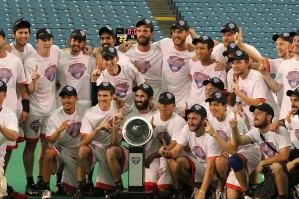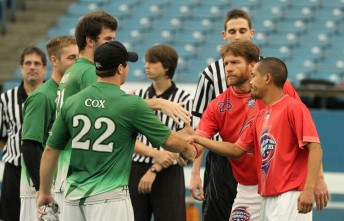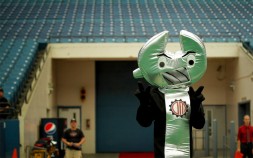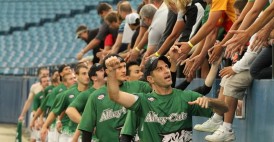 The first season has come to a close, with the Philadelphia Spinners taking down the Indianapolis Alleycats at the Pontiac Silverdome in Detroit. During the game, the AUDL tweeted that there were roughly 500 people in attendance. As can be gleaned our timeline and Ultiworld’s analysis, in addition to the Sportscenter top 10 clips, the AUDL has already seen its fair share of ownership trouble throughout the first season already. That trouble is complicated by the Spinners apparently receiving money from the AUDL for the franchises in their territory. Besides all the legal drama, the Columbus owner dropped out weeks into the season, and Ultiworld reported that the Boston franchise was purchased by AUDL employee/Mechanix owner Brent Steepe. Teams have also largely been in charge of their own promotion, with some securing a number of local sponsorships and others that have secured next to none. On the bright side though, the news media seems to be taking the sport more seriously: we have seen more of Ultimate in ESPN’s SportCenter Top 10 plays and Sports Nation TV shows – even if the streaming service touted by the league has fallen to the offerings of the NexGen Network, which covers both the college and club seasons.
The first season has come to a close, with the Philadelphia Spinners taking down the Indianapolis Alleycats at the Pontiac Silverdome in Detroit. During the game, the AUDL tweeted that there were roughly 500 people in attendance. As can be gleaned our timeline and Ultiworld’s analysis, in addition to the Sportscenter top 10 clips, the AUDL has already seen its fair share of ownership trouble throughout the first season already. That trouble is complicated by the Spinners apparently receiving money from the AUDL for the franchises in their territory. Besides all the legal drama, the Columbus owner dropped out weeks into the season, and Ultiworld reported that the Boston franchise was purchased by AUDL employee/Mechanix owner Brent Steepe. Teams have also largely been in charge of their own promotion, with some securing a number of local sponsorships and others that have secured next to none. On the bright side though, the news media seems to be taking the sport more seriously: we have seen more of Ultimate in ESPN’s SportCenter Top 10 plays and Sports Nation TV shows – even if the streaming service touted by the league has fallen to the offerings of the NexGen Network, which covers both the college and club seasons.
This paints a grim picture for the AUDL as a whole. Can the league survive into its second season? The large amount of support by the public and private investors for new franchises suggests a second season, and many more, are a reality. But in the history of sports leagues, this hasn’t always been a sign of positive things to come. Just two years into its infancy, Major League Soccer tried to expand with two additional teams from the starting point of 12, but quickly had to retract two other teams due to unsteady finances. After a new commissioner brought stability, the league started to expand. AEG at one point owned six MLS teams and Hunter Sports owned three, so the AUDL’s Steepe, with two franchises, isn’t historically out of line.
The Beaten Path
The path the AUDL seems to be taking is more alike to the Arena Football League. Since 1987, there have only been seven AFL seasons that haven’t seen a team added to the league but only one season (the first) that didn’t have a team fold, face suspension, or go under relocation due to struggling finances. Is the AFL a model of success that the AUDL should follow? It certainly seems as if the league is following in its footsteps with the expansion teams that have already been announced and the current suspension of the Constitution.
Could the AUDL’s placement of teams have something to do with the success of the league so far, and towards the future? In lacrosse, both the National Lacrosse League and Major League Lacrosse have seen teams move and relocate, with the MLL’s model of keeping teams in the Northeast reflecting the AUDL’s strategy in this regard. The National Hockey League currently faces finance issues as it currently nears what would be a second lockout of its players in less than 10 years, and with the league owning one team (Phoenix Coyotes) and two traditionally strong teams (New Jersey and the NY Islanders depending on reports) facing financial troubles of their own, more financial issues could arise for the league. Last year, the Atlanta Thrashers were sold due to a loss in revenue, which some pointed to their location in the southern United States, and relocated to a traditionally strong hockey market in Winnipeg, where they became the Jets. Two of the four teams mentioned are located in markets that aren’t associated with hockey – warm weather states. Success in warm weather and non-traditional markets has been a crusade of sorts of league commissioner Gary Bettman and he has been ridiculed endlessly for it. With the league fighting for more revenue and certain teams looking towards bankruptcy, many have called for the teams to move into traditional hockey markets in order to become more profitable and develop into strong assets for the league.
Most of the AUDL expansion teams for the 2013 season are in traditional Ultimate markets that have produced national championship qualifiers in the USAU/UPA championships for both the college and club series. But what of the other markets that the AUDL started off in? Columbus, Indianapolis, Detroit, and Buffalo all come to mind as teams placed in areas that don’t have a particularly developed talent pool. Expansion under financial duress has proven unsuccessful for other leagues that have tried, especially when teams have started in markets that traditionally haven’t been talent pools for the minor and youth league levels.
All for One
As of right now, it seems as if each team runs its own business while maintaining communication with the AUDL and complying with the league’s rules. Marketing is handled on a team by team basis and the decisions for new franchises seem to be a product of only the league offices. Not surprisingly, the finances of the major sports leagues are not readily available. We know that in most leagues, the players union and offices squabble over revenue sharing whenever they get the chance – to the detriment of fans, players, and owners alike. Major League Baseball has a system that takes a pool of money from their “Competitive Balance Tax”, individual teams, and the MLBPA and puts it towards a growth fund for the sport and the league. Imagine something similar to that in the AUDL; teams not only putting on clinics with local high school teams, and generating interest in the sport but putting money towards the youth programs of USAU. Occasionally, some items leak into the general public that give financial details but that isn’t a full picture of the league or of even the team. Though with publicly owned teams, fans are treated to an inside look at a teams finances, even if they aren’t trying to turn a profit like every other franchise; even if trading in team stock isn’t the best idea. That would be another concept that I’d like to see in the AUDL: not owners trying to make money off the sport, but simply trying to sustain themselves like the Green Bay Packers do. However, it’s a pipe-dream that won’t be possible for years, as the league first has to prove itself sustainable. The Arena Football League recently moved to a single-entity model, which means that the league owns the rights to the teams, players, coaches and everything else with a pool of money allocated to the teams to aid in travel costs. Prior to that, the AFL operated as its own business, and it didn’t fare well. As shown, the league hasn’t had many successful seasons, with many teams dropping out or taking a season or two off to recover financially. In Major League Soccer, profitability and the finances of each team have been directly tied to jersey sponsorship sales, like in international leagues. That, coupled with increasing revenue generated from TV deals and more play in sport-specific stadiums have allowed the league to project long term profitability for each club. This hasn’t come without hiccups though, as the league lost more than $350 million between its founding and 2004. When Major League Lacrosse was formed, it came in with some distinct advantages; the founder immediately secured league wide sponsorship from a leading lacrosse equipment manufacturer (Warrior Lacrosse) and soon after, a sponsorship from New Balance Athletics. The league was also quick to establish their version of the game at the high school and collegiate levels, which allowed players who had played at these levels to easily make the tradition to the professional leagues. These decisions have allowed the league to propel themselves and the sport into mainstream media.
Financial Victories for the AUDL?
So what is the path for financial success in the AUDL? The failure to meet championship game ticket sales targets and multiple lawsuits between the league and its franchise owners are not good omens for the first season. The answer might be to take a look at already existing sports leagues. The Arena Football League’s single-entity model doesn’t seem like it’s worth duplicating, though neither is their prior model of each team operating as it’s own business. The way the MLS has progressed seems like a model that could be emulated, though the fact that soccer was already well-known internationally greatly helped the success of the MLS. The MLS franchises’ strategy of selling jersey ad space may be an easily executed and supported idea. We’ve seen subtle ads on the jerseys of Sockeye and past teams, why not on a professional team’s jerseys too? Enticing big salaries for players is not in the near future of financial success in the league. In the National Lacrosse League most players have full-time jobs outside of their duties for their team – with players that teach or even serve on the police force. That wouldn’t be too far removed from the current journeys of club players now, and should be all that is expected of the AUDL for the time being.
Marketing the AUDL
Promotion of the AUDL and its teams is currently the main focus of all of those involved, because without promotion there is no sustainable model for revenue and success (and subsequently, money). But how does the AUDL market itself? Major League Soccer has had its fair share of promotion problems. Mention it to most fans of soccer, and they’ll say they prefer the Premier League because of the talent, among other reasons. Yet in this article on ESPN, a new marketing strategy is outlined by MLS’ Chief Marketing Officer Howard Handler. In it, he talks about how the league and its teams were first able to build up success on the local-market level through stadium acquisitions and expansion, yet saw no national results because of it. “To do that, our league needs to step up and project a nationwide identity by taking control of our own message and articulating it in our own words,” Handler explained. “The challenge now is to work out what we want to say.” MLS saw the local success by first stabilizing their finances, and then having their players gain clout on the world stage – while the 1998 World Cup team of largely MLS players was crushed, the 2002 World Cup team made the quarterfinals after beating Portugal and Mexico. For the AUDL, stabilizing finances is certainly the first step, as I outlined above. Having the AUDL follow in the footsteps of the MLS by creating stadiums specifically for Ultimate would be a rather large task to bestow upon them – the only pure-ultimate fields in the nation are TFDA’s Ultiplex and the Oshadega project, but at the least they might look to improve the stadium experience. Equipping the referees with microphones to explain calls to the fans should be step number one. With the difference in rules between the AUDL and USAU, it seemed at times that even the players were confused with the calls on the field, not to mention the casual fan. Some may speak of rule changes to more closely match USAU or WFDF rules.
Perhaps changing the rules isn’t necessary; international governing bodies in other sports often have differences with pro leagues such as FIBA and the NBA. But for basketball, the differences are always made clear during the game by the announcer and in the game program. Find a way to make the rule changes more well known during a game, and people will start picking them up. In the big picture though, the AUDL and its teams need to step up their marketing efforts to the public. Getting the team in the local newspaper or using players’ Facebook friends to get fellow Ultimate players in the seats at games isn’t enough. It’s the casual sports fan that need to become the focus of the AUDL’s marketing, enough so that they are encouraged to not only come to one game but to purchase season tickets and watch an entire season play out. What does this sport offer casual fans that others don’t? What sets it apart? Getting each franchise grounded into the local sports scene, through appearances at local music and art festivals (as it seems the Philadelphia Spinners have done), recaps in the weekend sports page, and commercials and sponsorships of other sports programs will attract those fans. Without these casual fans, the league will have to depend on family and friends of players, which isn’t enough for financial stability.
The Big Picture
Once promotion and fan attendance improves across each location, the AUDL should focus on their media offerings in order to attract a national audience – just as the MLS has done. The highlight packages put together currently by Skyd and individual teams are useful for teasing the sport and helping it gain more national attention on ESPN and other mass media. However, the AUDL’s streaming service is lackluster when compared to the NexGen Network, who provide a cheaper offering, video-on-demand, and more coverage. Turning on a regional sports station and seeing an AUDL game is out of the question right now. If we take a look at other sports and their TV coverage, the Arena Football League has its games on the NFL Network and regional broadcasts currently, but late night tape delay (if any coverage) was the best the league could muster for most of its early years. Major League Lacrosse and the National Lacrosse League have at best gotten some minor ESPN coverage, but are mostly shown on CBS Sports Network. And lastly, Major League Soccer, who until recently was stuck on regional sports networks, now has games both there and on ESPN and the NBC Sports Network. Each of those sports has been an established staple of the North American sports scene for decades, and features players on the international stage as well. Ultimate may have national and international support, but hasn’t been established long enough to gain the attention of the networks. Any network that would potentially be interested in the league at the time being, though, would likely be scared away by the ongoing legal battle and finance situation. For other sports leagues, the mere threat of a labor dispute has been enough to stop TV coverage or to tape-delay the games (which decreases viewership). Until fan attendance improves, the AUDL should stay away from trying to get TV contracts. As the NFL has said time and time again, it is attendance that makes the big money (which is why they implement a blackout policy).
What, then, should the AUDL be focusing on? What can they learn after looking at other professional sports leagues? For one thing, stop expanding. Sure they haven’t hit major markets west of the Mississippi, but for now they need to work on building up strong markets in the current franchises. Could they even generate the revenue to support traveling across the nation at such a young start? I wouldn’t think so, as travel times would be too severe using buses and cars to go between games, especially as most of the players have full-time jobs. If markets such as Columbus, Detroit and Buffalo become hotbeds for the sport, then more expansion becomes a reality. Once the expansion is halted, they need to fix up the rest of the league’s finances. Priority number one is getting the lawsuit with the Constitution and Rampage settled as soon as possible – the more it drags on, the more negative PR the league has to deal with. Increasing promotion and participation in the league and the sport would be a two-birds-one-stone kind of way to increase interest in the sport and the teams. As the blog Pushpass discussed, professional Ultimate isn’t just a pipe dream anymore, the AUDL did show us that it’s possible to professionalize our sport. The finals “still felt like Ultimate” and if the business behind the league improves then it could really be around 5 years from now; and even longer if their model holds up. With one year in the books, what’s next for the AUDL? There are new teams popping up all over the place, including Madison, Toronto, Chicago, New York (no Boston team announced yet)– traditionally great Ultimate markets that have been producing USAU college and club contenders for quite some time. There may be a talent draw problem currently, as made apparent in the Spinners fantasy draft, but that will hopefully be solved by the league popping up in traditional Ultimate hot-beds.
Feature photo by Jen Crandon












Comments Policy: At Skyd, we value all legitimate contributions to the discussion of ultimate. However, please ensure your input is respectful. Hateful, slanderous, or disrespectful comments will be deleted. For grammatical, factual, and typographic errors, instead of leaving a comment, please e-mail our editors directly at editors [at] skydmagazine.com.